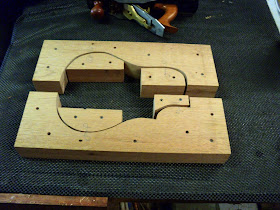Nomenclature
Just a quick refresher on the naming of parts of a ukulele so we all know what I'm talking about.
These two ukuleles are of traditional shape - the lower one is a concert size and the upper a tenor. They have different length necks, and their scales for the fretboard differ as well.
The nomenclature is the same for all ukuleles no matter the shape - even for boat paddle tenors.............
........ and for the purposes of this little instalment, I'll refer to the timbers for the front, back and sides of the ukulele body as skins.
Skins
I have already thicknessed all of these parts so they are ready to have their edges dressed for jointing.
Both the front - the soundboard - and the back will be made up of a pair of book-matched pieces of mango that I cut previously.
The joined edges of these two pieces will have to be absolutely straight, so that they glue true and remain strong after the glue dries.
I have made a shooting board so that the edges can be planed truly straight.
Like many things in my workshop, it is made from leftovers and re-cycled material.
A formica covered plywood desk lid and some wormy old jacaranda make up the shooting board.
Here are the skins for the back being jointed.
In the first image, the side skins are being dressed on one side - the edge that will interface with the the top (the soundboard). These edges need to be dead straight, as the soundboard will be almost flat. It will have a slight radius, but we'll get to that later.
Fretboard and Headstock
Because the mango for the body has such a pronounced grain pattern, I want the fretboard to be as plain as possible.
I have a piece of African blackwood that will serve nicely.
It is rough sawn and needs to have one side dressed before I re-saw it to thickness.
Man this timber is tough on blades. I had to re-sharpen the plane blade in the middle of this.
This trued edge runs against the bandsaw fence and has to be straight, or the ripping will cut awry.
The result of this cut will see two pieces of different thickness - one for the fretboard, and the thinner piece will supply the headboard and any trim.
This timber is haaarrrddd, and it has to be cut slowly.
Off the saw, it is full of bandsaw marks and needs dressing. I have cut both of these pieces oversize to allow plenty in bringing it back to thickness by planing and sanding.
Here are the finished pieces, showing some very beautiful, but simple, grain pattern.
The relative thickness of each can be seen in this shot - fretboard on the left, headboard on the right.
I'll need a full day to make a start on building the curved sides of the body.
Next time..................





























